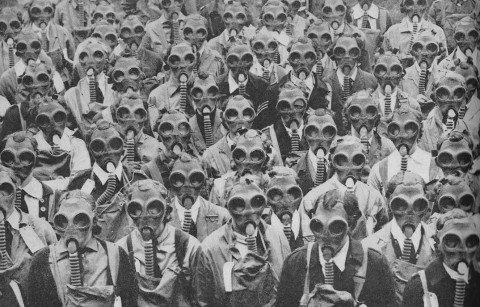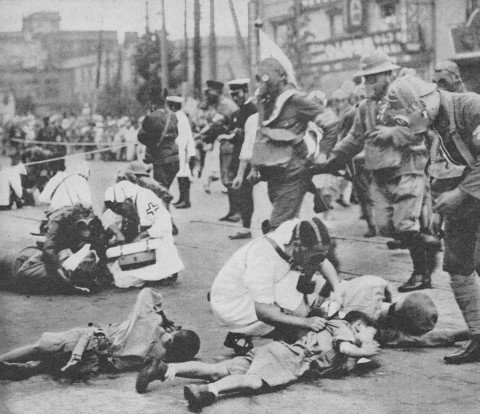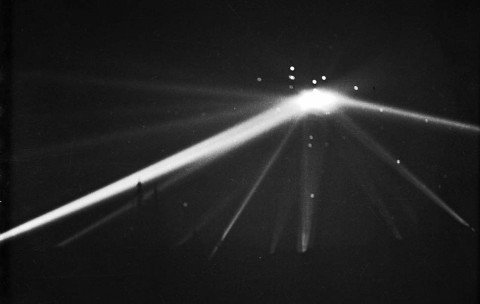SUCH THINGS WILL HAPPEN
In April, 1935, a Kentish Voluntary Aid Detachment of the British Red Cross Society conducted an air raid rehearsal. Here Red Cross men wearing box respirators and anti-gas clothing are rescuing a woman caught by gas in the open. With a heavy concentration of the deadly gases that modern chemists have now evolved there is little chance she would survive for more than a few minutes.
These images are from Boyd Cable, ‘New horrors of air attack’, in John Hammerton, ed., War in the Air: Aerial Wonders of our Time (London: Amalgamated Press, n.d. [1936]), 143-6, the third article in a series on ‘Things of tomorrow’, following on ‘Death from the skies’ and ‘The doom of cities’.
Here Cable really steps up the scaremongering by examining the destructive powers of bombers. For example:
- ‘An explosive or “brianz” bomb of about 1,000 lb. will now demolish a whole block of houses, even if it only falls close to and not on them’.
- A thermite incendiary can burn at up to 5000°C:
It will melt steel, eat through stone, cause anything even moderately inflammable near it to burst into flames. Water actually increases the incendiary effect, and there is no known means of extinguishing the mixture.
- ‘A formation of ten bombers can start 10,000 fires in a city.’
- On ‘poison-gas bombers’:
It will almost be a matter of indifference to the bombers whether their poison kills or injures 5 per cent. or 50 per cent. of their victims. The main purpose will be achieved by forcing all air defence workers who have gas-masks to put them and wear them continuously, and by inflicting such torture and death, by choking and blistering gas, on even a small proportion of men, women and children drive the panic-stricken people into mad stampeding efforts to fly from the area.
- On new gases: ‘only those in the laboratories of the various nations know what other terrors have been invented and kept hidden but ready for the next war’.
- On mustard gas: ‘Anyone walking on it or brushing against it, carries the poison into house or dug-out, where it vaporizes and kills’.
- On Lewisite:
Bombers carrying 16 cwt. of Lewisite can spread a 20-foot-thick blanket of deadly poison over one square mile. Putting it another way, 10 bombers carrying 5,000 lb. of Lewisite each can poison an area of 10 miles long by seven miles wide.
- On the prospects for civil defence:
It is plainly impossible that entire cities can be made impervious to explosive or incendiary bombs, and no less impossible that all the men, women and children in our cities can be provided with the ‘essential’ masks and ‘special clothing’ to protect us all against all the various types of poison gas.
Unsurprisingly, Cable can offer little hope to his readers. The only defence is deterrence, the ability to do the same to any attacker; beyond that,
It may be a question whether it would pay the most sadistic seeker of victory so to wreck and ruin an enemy country that at the finish the smoking ruins of cities, the maimed, crippled, disease-ravaged population would not be worth the conquering, possessing and ruling.
And maybe, just maybe, air defence, which he hints he will discuss in a future article.
MASKED AGAINST DEATH
These are men of a Voluntary Aid Detachment undergoing anti-gas instruction at Winchester. They are wearing the latest type of box respirator, and the grotesque and horrible appearance that the equipment gives them emphasizes the ghastliness of the form of warfare for which they are prepared.
RAID PAST: DEATH STILL LURKS
Here is a scene in a Berlin street after a mimic air raid. In this quarter of the city, mustard gas was actually used, and road sweepers, equipped with masks and anti-gas clothing, are cleansing the contaminated streets which would otherwise have emitted poisonous fumes for many hours after the raid was over.
JAPAN PREPARES FOR GAS ATTACK
In Japan, anti-gas drill has been carried out under Government control with the same thoroughness that it has been in Germany, and the traffic of cities has been held up while war-time conditions were reproduced. This photograph shows a scene near Nippon Bridge, Tokio, while a mimic raid was in progress. Soldiers, police and ambulance men in gas-masks are attending to those who have been gassed, and civilians, including women and children, have been pressed into service to represent casualties.
HOW DEATH COMES FROM THE AIR
After Germany re-armed in the air, opportunity was taken not only to let the people see the efficiency of the men and machines but also to give them visual warning of possible ‘things to come.’ Here models of scattered buildings have been erected and a squadron of aeroplanes swooping down demonstrates the accuracy of aim now possible. The bomb seen exploding is of a new type, capable of completely obliterating a substantial building.
Some of these photographs bear on earlier posts. The one of the crowd of men wearing gas masks is a differently cropped version of a photo published in Poison Gas (London: Union of Democratic Control, 1935) which I reproduced here (I think it was taken at the same exercise as the top photograph). The Tokyo exercise predates the Japanese ARP posters discussed here by at least a year or two, showing that fear of gas attacks was growing even in the mid-1930s. And the final shot of the Luftwaffe’s biplane bombers attacking mock buildings looks very much like a Hendon set-piece analogue.
![]() This work is licensed under a Creative Commons Attribution-NonCommercial-NoDerivatives 4.0 International License.
Permissions beyond the scope of this license may be available at http://airminded.org/copyright/.
This work is licensed under a Creative Commons Attribution-NonCommercial-NoDerivatives 4.0 International License.
Permissions beyond the scope of this license may be available at http://airminded.org/copyright/.









